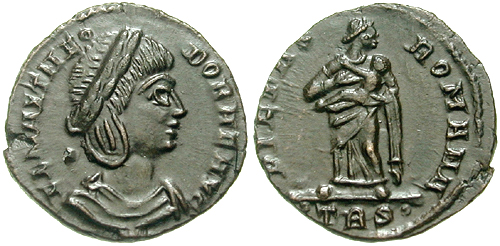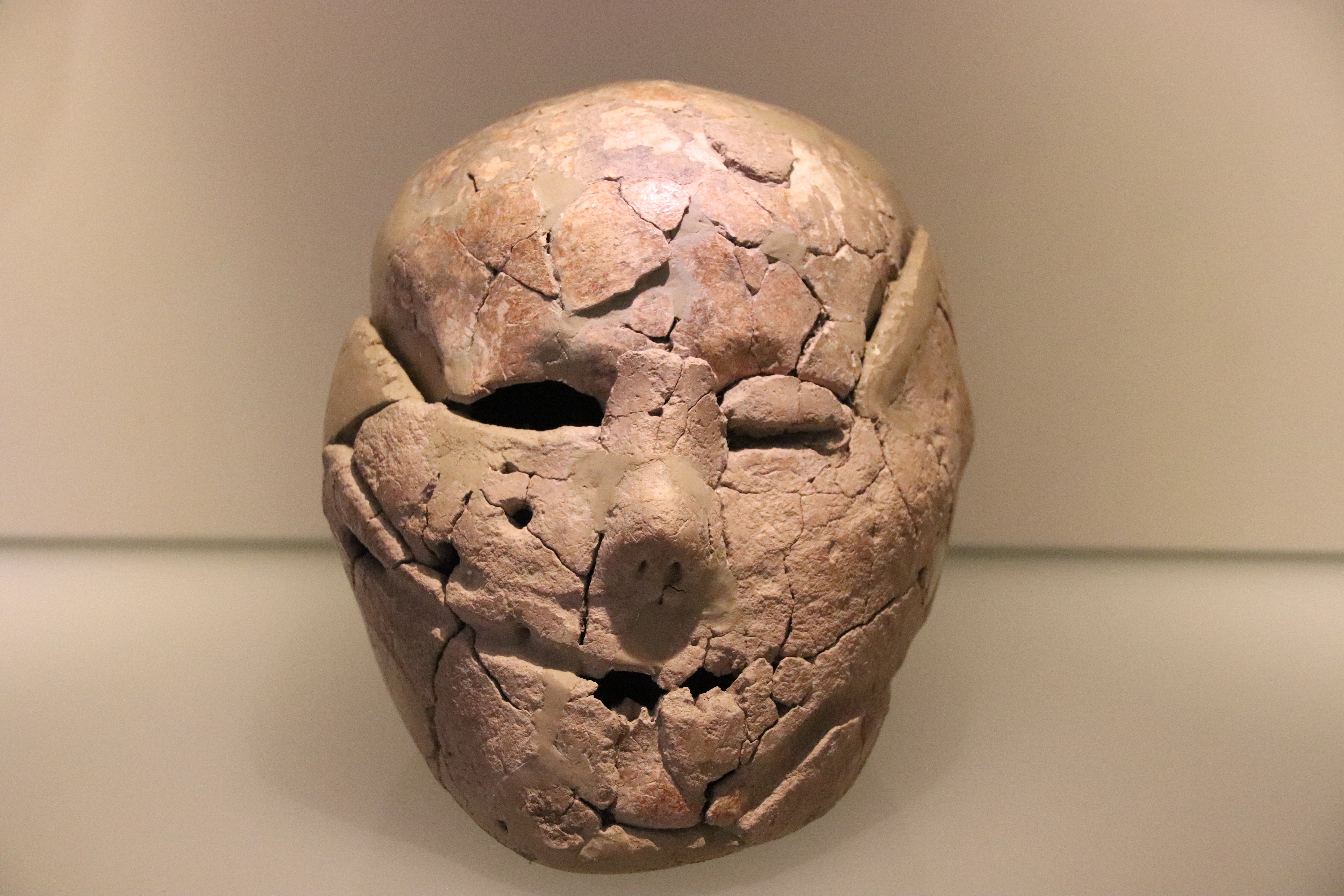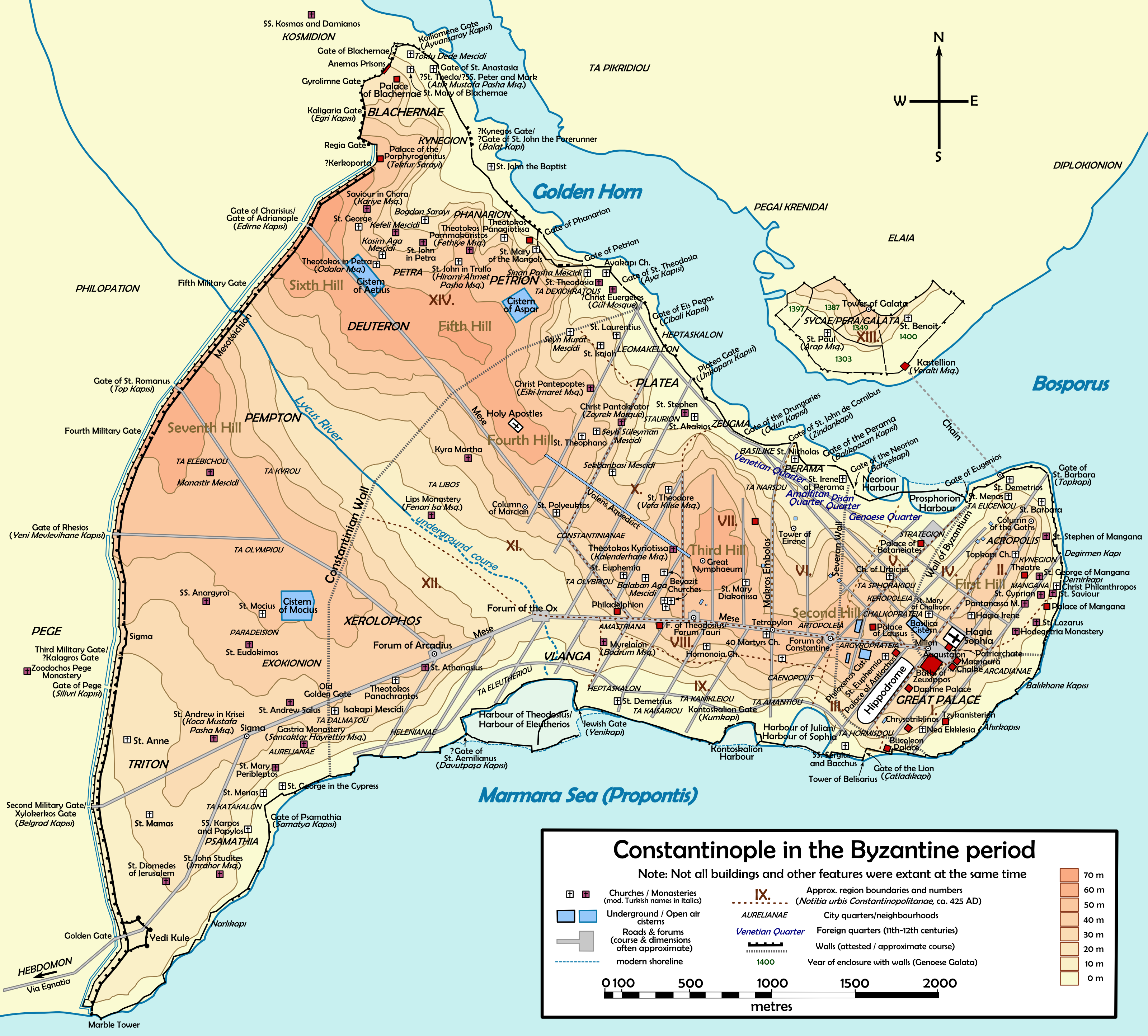|
Portrait Of The Four Tetrarchs
The Portrait of the Four Tetrarchs is a porphyry sculpture group of four Roman emperors dating from around 300 AD. The sculptural group has been fixed to a corner of the façade of St Mark's Basilica in Venice, Italy since the Middle Ages. It probably formed part of the decorations of the Philadelphion in Constantinople, and was removed to Venice in 1204 or soon after. ''Spolia'' from the Fourth Crusade, the statues were originally designed as two separate sculptures, each consisting of a pair of armoured late Roman emperors embracing one another. The paired statues stand on plinths supported by a console of the same stone, and their backs are engaged in the remains of large porphyry columns to which the statues were once attached, carved all of a piece. The columns no longer exist, and one emperor pair is missing part of the plinth and an emperor's foot, which has been found in Istanbul. One statue pair has been sliced vertically and is missing a large portion of the right-h ... [...More Info...] [...Related Items...] OR: [Wikipedia] [Google] [Baidu] |
Venice – The Tetrarchs 03
Venice ( ; it, Venezia ; vec, Venesia or ) is a city in northeastern Italy and the capital of the Veneto region. It is built on a group of 118 small islands that are separated by canals and linked by over 400 bridges. The islands are in the shallow Venetian Lagoon, an enclosed bay lying between the mouths of the Po and the Piave rivers (more exactly between the Brenta and the Sile). In 2020, around 258,685 people resided in greater Venice or the ''Comune di Venezia'', of whom around 55,000 live in the historical island city of Venice (''centro storico'') and the rest on the mainland (''terraferma''). Together with the cities of Padua and Treviso, Venice is included in the Padua-Treviso-Venice Metropolitan Area (PATREVE), which is considered a statistical metropolitan area, with a total population of 2.6 million. The name is derived from the ancient Veneti people who inhabited the region by the 10th century BC. The city was historically ... [...More Info...] [...Related Items...] OR: [Wikipedia] [Google] [Baidu] |
Constantius Chlorus
Flavius Valerius Constantius "Chlorus" ( – 25 July 306), also called Constantius I, was Roman emperor from 305 to 306. He was one of the four original members of the Tetrarchy established by Diocletian, first serving as caesar from 293 to 305 and then ruling as augustus until his death. Constantius was also father of Constantine the Great, the first Christian emperor of Rome. The nickname Chlorus () was first popularized by Byzantine-era historians and not used during the emperor's lifetime. After his re-conquering of Roman Britain, he was given the title 'Redditor Lucis Aeternae', meaning 'The Restorer of Eternal Light'. Of humble origin, Constantius had a distinguished military career and rose to the top ranks of the army. Around 289 he set aside Helena, Constantine's mother, to marry a daughter of Emperor Maximian, and in 293 was added to the imperial college by Maximian's colleague, Diocletian. Assigned to rule Gaul, Constantius defeated the usurper Carausius ther ... [...More Info...] [...Related Items...] OR: [Wikipedia] [Google] [Baidu] |
Istanbul Archaeology Museum
The Istanbul Archaeology Museums ( tr, ) are a group of three archaeological museums located in the Eminönü quarter of Istanbul, Turkey, near Gülhane Park and Topkapı Palace. The Istanbul Archaeology Museums consists of three museums: #Archaeological Museum (in the main building) #Museum of the Ancient Orient # Museum of Islamic Art (in the Tiled Kiosk). It houses over one million objects that represent almost all of the eras and civilizations in world history. Background The origins of the museum can be traced back to the nearby Hagia Irene Church. After the conquest of Istanbul, the church's location close to the barracks of the Janissaries saw it transformed into a de facto ‘inner arsenal’ for storing their weapons ( ''İç'' ''Cebehane'' in Turkish). By 1726, during the reign of Sultan Ahmed III, it functioned as a full-fledged armory known as ''Dar''-''ül'' ''Esliha'', or “House of Weapons” in Turkish. By the 19th century, the church was also being used to ... [...More Info...] [...Related Items...] OR: [Wikipedia] [Google] [Baidu] |
Bodrum Mosque
Bodrum Mosque ( tr, Bodrum Camii, or ''Mesih Paşa Camii'' named after its converter) in Istanbul, Turkey, is a former Eastern Orthodox church converted into a mosque by the Ottomans. The church was known under the Greek name of Myrelaion ( el, Eκκλησία του Μυρελαίου). Location The beautiful Byzantine structure is today rather incongruously choked on three sides by modern apartment blocks. It stands in Istanbul, in the district of Fatih, in the neighbourhood of Laleli, one kilometre west of the ruins of the Great Palace of Constantinople. History Some years before 922, possibly during the wars against Simeon I's Bulgaria, the ''drungarius'' Romanos Lekapenos bought a house in the ninth region of Constantinople, not far from the Sea of Marmara, in the place called ''Myrelaion'' ("the place of myrrh" in Greek). After his accession to the throne this building became the nucleus of a new imperial palace, intended to challenge the neighbouring Great Palace of Cons ... [...More Info...] [...Related Items...] OR: [Wikipedia] [Google] [Baidu] |
Portrait Of The Four Tetrarchs, A Porphyry Sculpture Sacked From The Byzantine Philadelphion Palace In 1204, Treasury Of St
A portrait is a painting, photograph, sculpture, or other artistic representation of a person, in which the face and its expressions are predominant. The intent is to display the likeness, personality, and even the mood of the person. For this reason, in photography a portrait is generally not a snapshot, but a composed image of a person in a still position. A portrait often shows a person looking directly at the painter or photographer, in order to most successfully engage the subject with the viewer. History Prehistorical portraiture Plastered human skulls were reconstructed human skulls that were made in the ancient Levant between 9000 and 6000 BC in the Pre-Pottery Neolithic B period. They represent some of the oldest forms of art in the Middle East and demonstrate that the prehistoric population took great care in burying their ancestors below their homes. The skulls denote some of the earliest sculptural examples of portraiture in the history of art. Historical portraitur ... [...More Info...] [...Related Items...] OR: [Wikipedia] [Google] [Baidu] |
Mese (Constantinople)
The ''Mese'' ( el, ''i Mése dós', lit. "Middle treet) was the main thoroughfare of ancient Constantinople and the scene of many Byzantine imperial processions. Its ancient course is largely followed by the modern ''Divan Yolu'' ("Road to the Divan"). Route of the Mese The ''Mese'' started at the Milion monument, close to the Hagia Sophia, and led straight westwards. It passed the Hippodrome and the palaces of Lausos and Antiochus, and after ca. 600 meters reached the oval-shaped Forum of Constantine where one of the city's two Senate houses stood. This stretch of the street was also known as the ''Regia'' (, "Imperial Road"), as it formed the original ceremonial route from the Great Palace and the Augustaion square to the forum of the city's founder. From there, the street continued to the square Forum of Theodosius or Forum of the Bull (''Forum Tauri''), as it was also known. In about the middle of this stretch, the great mall known as ''Makros Embolos'' joined ... [...More Info...] [...Related Items...] OR: [Wikipedia] [Google] [Baidu] |
Portico
A portico is a porch leading to the entrance of a building, or extended as a colonnade, with a roof structure over a walkway, supported by columns or enclosed by walls. This idea was widely used in ancient Greece and has influenced many cultures, including most Western cultures. Some noteworthy examples of porticos are the East Portico of the United States Capitol, the portico adorning the Pantheon in Rome and the portico of University College London. Porticos are sometimes topped with pediments. Palladio was a pioneer of using temple-fronts for secular buildings. In the UK, the temple-front applied to The Vyne, Hampshire, was the first portico applied to an English country house. A pronaos ( or ) is the inner area of the portico of a Greek or Roman temple, situated between the portico's colonnade or walls and the entrance to the '' cella'', or shrine. Roman temples commonly had an open pronaos, usually with only columns and no walls, and the pronaos could be as lon ... [...More Info...] [...Related Items...] OR: [Wikipedia] [Google] [Baidu] |
Byzantium
Byzantium () or Byzantion ( grc, Βυζάντιον) was an ancient Greek city in classical antiquity that became known as Constantinople in late antiquity and Istanbul today. The Greek name ''Byzantion'' and its Latinization ''Byzantium'' continued to be used as a name of Constantinople sporadically and to varying degrees during the thousand year existence of the Byzantine Empire. Byzantium was colonized by Greeks from Megara in the 7th century BC and remained primarily Greek-speaking until its conquest by the Ottoman Empire in AD 1453. Etymology The etymology of ''Byzantium'' is unknown. It has been suggested that the name is of Thracian origin. It may be derived from the Thracian personal name Byzas which means "he-goat". Ancient Greek legend refers to the Greek king Byzas, the leader of the Megarian colonists and founder of the city. The name '' Lygos'' for the city, which likely corresponds to an earlier Thracian settlement, is mentioned by Pliny the Elder in hi ... [...More Info...] [...Related Items...] OR: [Wikipedia] [Google] [Baidu] |
Egypt
Egypt ( ar, مصر , ), officially the Arab Republic of Egypt, is a transcontinental country spanning the northeast corner of Africa and southwest corner of Asia via a land bridge formed by the Sinai Peninsula. It is bordered by the Mediterranean Sea to the north, the Gaza Strip of Palestine and Israel to the northeast, the Red Sea to the east, Sudan to the south, and Libya to the west. The Gulf of Aqaba in the northeast separates Egypt from Jordan and Saudi Arabia. Cairo is the capital and largest city of Egypt, while Alexandria, the second-largest city, is an important industrial and tourist hub at the Mediterranean coast. At approximately 100 million inhabitants, Egypt is the 14th-most populated country in the world. Egypt has one of the longest histories of any country, tracing its heritage along the Nile Delta back to the 6th–4th millennia BCE. Considered a cradle of civilisation, Ancient Egypt saw some of the earliest developments of writing, agr ... [...More Info...] [...Related Items...] OR: [Wikipedia] [Google] [Baidu] |
Tetrarchy
The Tetrarchy was the system instituted by Roman emperor Diocletian in 293 AD to govern the ancient Roman Empire by dividing it between two emperors, the ''augusti'', and their juniors colleagues and designated successors, the '' caesares''. This marked the end of the Crisis of the Third Century. Initially Diocletian chose Maximian as his ''caesar'' in 285, raising him to co-''augustus'' the following year; Maximian was to govern the western provinces and Diocletian would administer the eastern ones. The role of the ''augustus'' was likened to Jupiter, while his ''caesar'' was akin to Jupiter's son Hercules. Galerius and Constantius were appointed ''caesares'' in March 293. Diocletian and Maximian retired on 1 May 305, raising Galerius and Constantius to the rank of ''augustus''. Their places as ''caesares'' were in turn taken by Valerius Severus and Maximinus Daza. The orderly system of two senior and two junior rulers endured until Constantius died in July 306, and ... [...More Info...] [...Related Items...] OR: [Wikipedia] [Google] [Baidu] |
Roman Empire
The Roman Empire ( la, Imperium Romanum ; grc-gre, Βασιλεία τῶν Ῥωμαίων, Basileía tôn Rhōmaíōn) was the post- Republican period of ancient Rome. As a polity, it included large territorial holdings around the Mediterranean Sea in Europe, North Africa, and Western Asia, and was ruled by emperors. From the accession of Caesar Augustus as the first Roman emperor to the military anarchy of the 3rd century, it was a Principate with Italia as the metropole of its provinces and the city of Rome as its sole capital. The Empire was later ruled by multiple emperors who shared control over the Western Roman Empire and the Eastern Roman Empire. The city of Rome remained the nominal capital of both parts until AD 476 when the imperial insignia were sent to Constantinople following the capture of the Western capital of Ravenna by the Germanic barbarians. The adoption of Christianity as the state church of the Roman Empire in AD 380 and the fall of th ... [...More Info...] [...Related Items...] OR: [Wikipedia] [Google] [Baidu] |
Smarthistory Smarthistory is a free resource for the study of art history created by art historians Beth Harris and Steven Zucker. Smarthistory is an independent not-for-profit organization and the official partner to Khan Academy for art history. Smarthistory started in 2005 as an audio guide series for use at the Metropolitan Museum of Art The Metropolitan Museum of Art of New York City, colloquially "the Met", is the largest art museum in the Americas. Its permanent collection contains over two million works, divided among 17 curatorial departments. The main building at 100 ..., The Museum of Modern Art in New York City, and as a resource for students taking introductory art history courses at the college level. In addition to its focus on college-level courses in art history, Smarthistory supports the art history Advanced Placement course and examination developed by The College Board. Smarthistory provides essays, video, photographs, and links to additional resources for each o ... [...More Info...] [...Related Items...] OR: [Wikipedia] [Google] |

.jpg)






%2C_Rome.jpg)